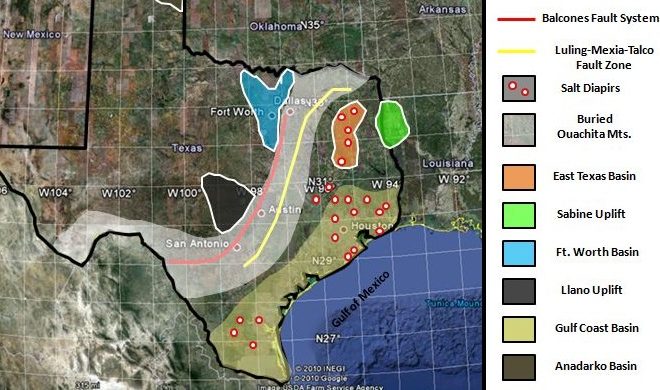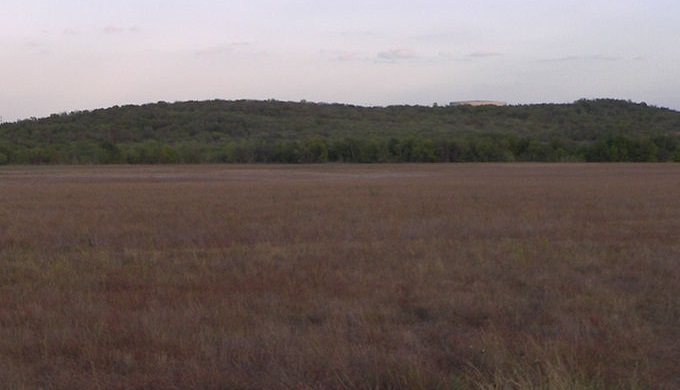Geology facts about the Texas Hill Country originate before the dinosaurs and cannot compare to other parts of the state. The materials underground make this portion of the state so unique. During prehistoric times, the landscape experienced multiple changes that eventually gave the region its distinctive look today. Given a picture of the Texas Hill Country from millions of years ago, few would recognize it compared to the verdant hills that dominate the landscape today.
 Photo: Wikimedia Commons
Photo: Wikimedia Commons
Nature
5 Texas Hill Country Geology Facts That’ll Surprise You
1. Volcanoes Once Reigned

Photo: Wikimedia Commons/Larry D. Moore CC BY-SA 3.0
Geology facts about the ancient landscape are often surprising. Volcanoes once loomed over the Texas Hill Country landscape, spouting lava onto the area. Today, you can still see vestiges of these ancient hills. An ancient volcano created Pilot Knob, located outside of Austin. Today four hills stand above the landscape, but in prehistoric times, these hills would have been inside a volcano that erupted below the surface of a Cretaceous sea. But don’t worry. Geologists consider these volcanoes extinct because none have erupted for millions of years.
2. There’s Gold in Those Hills!

Photo: Wikimedia Commons
California is not the only place to find gold in the United States. At one time, miners sought gold in the Heath mine near Llano. Though this mine no longer operates, it proved productive for a short while, yielding minor amounts of both gold and bismuth. Nearby Gold Mine Creek immortalizes the short few years at the end of the 19th century when miners searched for gold in the Texas Hill Country.
Most of the gold found in the Llano Uplift area, near Enchanted Rock, flows through the streams, but don’t grab a pan to start searching for gold in the creeks yourself. Private owners control almost all the land in the area, and you should not enter anyone’s property without their permission. It may be just as well. Civil War-era residents of the area were only able to accumulate one dollar worth of gold a day by panning in the creeks.
3. Home to Texas’s State Gem

Photo: Wikimedia Commons
Did you know that Texas has a state gem? Blue topaz only comes from one place in the state, near Mason, located about an hour northwest of Fredericksburg. If you want to find your own topaz, Mason has several ranches, such as the Lindsay Ranch and Bar M Ranch, where you can try your hand at finding this gem yourself. Unlike gold, the Texas Hill Country has a lot more topaz under the ground, so you may get lucky and find a gemstone or two on your next trip.
4. Ancient Creatures Created the Caves

Photo: Wikimedia Commons
Water seeping through limestone created many of the caves in the Texas Hill Country, but do you know where limestone comes from? Look at a sample of limestone, and you’ll see the impressions of seashells that formed the rock. But how can seashells create rock in the Texas Hill Country, hundreds of miles from the nearest ocean? Millions of years ago, a shallow sea covered parts of Texas. When the marine life in this ocean died, their bodies would sink to the bottom of the ocean. Over time, the calcium from the bones and shells of those creatures created the limestone under the ground in Texas today.
Limestone is also very delicate. Water dissolving the limestone combined with natural fractures in the rock eventually carve out the extensive caves found under the Hill Country. The impressive stalactites and stalagmites found in Natural Bridge Caverns and other area caves develop from water seeping through the limestone-filled rocks above and dripping to the floor of the cave. As the water slowly drips down, it evaporates, leaving behind the limestone on the rock surface. Over the years, the stalactites, which hang down from the ceiling, and the stalagmites, which rise from the floor, increase in length by minute amounts each year. Knowing these geology facts might make your next trip to a Texas cave a little more interesting.
5. The Hills Were Once Mountains

Photo: Wikimedia Commons
Many geology facts about the region have their origins millions of years ago, including when mountains loomed over the landscape. Between 350 and 240 million years ago, a large mountain range extended down through the Texas Hill Country to Marathon on the southern end through Arkansas on the northern end. Today, you can visit the remains of the Ouachita Mountain range near Marathon, Texas; in southwestern Arkansas and in eastern Oklahoma. Time buried most of the Texas portion of this mountain range.
Sources:
Wikipedia Pilot Knob
TSHAOnline.org Geology
Wikipedia Llano Uplift
Texfiles.com Panning for Texas Gold
Texfiles.com There’s (Some) Gold in Them There Hills
DallasNews.com Find Gems Near Mason, the Topaz Capital of Texas
Texas Almanac Geology of Texas
TSHAOnline.org Caves


